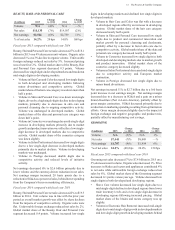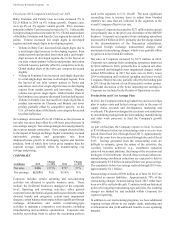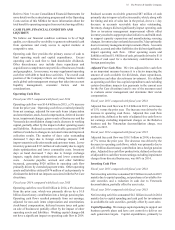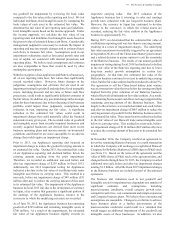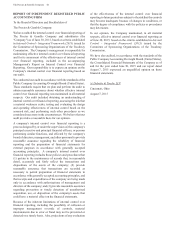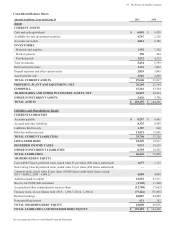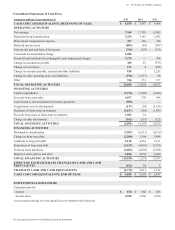Proctor and Gamble 2015 Annual Report Download - page 42
Download and view the complete annual report
Please find page 42 of the 2015 Proctor and Gamble annual report below. You can navigate through the pages in the report by either clicking on the pages listed below, or by using the keyword search tool below to find specific information within the annual report.The Procter & Gamble Company 40
considered the structure and value of the divestiture agreement
with H in the impairment testing for atteries. If the value
of Hs shares of the Company declines further before the
transaction closing dates, we may need to record additional
non-cash impairment charges as part of discontinued
operations in the future.
See Note 2 to our Consolidated Financial Statements for
additional discussion on goodwill and intangible asset
impairment testing results.
New Accounting Pronouncements
Refer to Note 1 to the Consolidated Financial Statements for
recently adopted accounting pronouncements and recently
issued accounting pronouncements not yet adopted as of
June 30, 2015.
OTHER INFORMATION
Hedging and Deriatie Financial Instruments
As a multinational company with diverse product offerings,
we are exposed to market risks, such as changes in interest
rates, currency exchange rates and commodity prices. e
evaluate exposures on a centralized basis to take advantage of
natural exposure correlation and netting. Except within
financing operations, we leverage the Company's diversified
portfolio of exposures as a natural hedge and prioritize
operational hedging activities over financial market
instruments. To the extent we choose to further manage
volatility associated with the net exposures, we enter into
various financial transactions which we account for using the
applicable accounting guidance for derivative instruments and
hedging activities. These financial transactions are governed
by our policies covering acceptable counterparty exposure,
instrument types and other hedging practices. Note 5 to the
Consolidated Financial Statements includes a detailed
discussion of our accounting policies for derivative
instruments.
Derivative positions are monitored using techniques including
market valuation, sensitivity analysis and value-at-risk
modeling. The tests for interest rate, currency rate and
commodity derivative positions discussed below are based on
the CorporateManager value-at-risk model using a one-year
horizon and a 95 confidence level. The model incorporates
the impact of correlation (the degree to which exposures move
together over time) and diversification (from holding multiple
currency, commodity and interest rate instruments) and
assumes that financial returns are normally distributed.
Estimates of volatility and correlations of market factors are
drawn from the RiskMetrics dataset as of June 30, 2015. In
cases where data is unavailable in RiskMetrics, a reasonable
proxy is included.
Our market risk exposures relative to interest rates, currency
rates and commodity prices, as discussed below, have not
changed materially versus the previous reporting period. In
addition, we are not aware of any facts or circumstances that
would significantly impact such exposures in the near term.
nteest Rte pose on nncl nstments Interest
rate swaps are used to hedge exposures to interest rate
movement on underlying debt obligations. Certain interest rate
swaps denominated in foreign currencies are designated to
hedge exposures to currency exchange rate movements on our
investments in foreign operations. These currency interest rate
swaps are designated as hedges of the Company's foreign net
investments.
ased on our interest rate exposure as of and during the year
ended June 30, 2015, including derivative and other
instruments sensitive to interest rates, we believe a near-term
change in interest rates, at a 95 confidence level based on
historical interest rate movements, would not materially affect
our financial statements.
enc Rte pose on nncl nstments ecause
we manufacture and sell products and finance operations in a
number of countries throughout the world, we are exposed to
the impact on revenue and expenses of movements in currency
exchange rates. Corporate policy prescribes the range of
allowable hedging activity. To manage the exchange rate risk
associated with the financing of our operations, we primarily
use forward contracts with maturities of less than 18 months.
In addition, we enter into certain currency swaps with
maturities of up to five years to hedge our exposure to exchange
rate movements on intercompany financing transactions.
ased on our currency rate exposure on derivative and other
instruments as of and during the year ended June 30, 2015, we
believe, at a 95 confidence level based on historical currency
rate movements, the impact of a near-term change in currency
rates would not materially affect our financial statements.
ommot ce pose on nncl nstments e
use raw materials that are subject to price volatility caused by
weather, supply conditions, political and economic variables
and other unpredictable factors. e may use futures, options
and swap contracts to manage the volatility related to the above
exposures.
As of and during the years ended June 30, 2015 and June 30,
2014, we did not have any commodity hedging activity.
Measures Not Defined B U.S. GAAP
Our discussion of financial results includes several non-
GAAP financial measures. e believe these measures
provide our investors with additional information about our
underlying results and trends, as well as insight to some of the
metrics used to evaluate management. hen used in the
MD&A, we have provided the comparable U.S. GAAP
measure in the discussion. These measures include:
nc les ot Organic sales growth is a non-GAAP
measure of sales growth excluding the impacts of acquisitions,
divestitures and foreign exchange from year-over-year
comparisons. e believe this provides investors with a more
complete understanding of underlying sales trends by
providing sales growth on a consistent basis. Organic sales is
also one of the measures used to evaluate senior management
and is a factor in determining their at-risk compensation.



